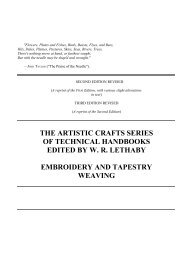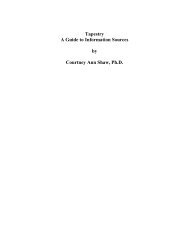3rd European textile and Fibre Art Festival - Catalogue
3rd European textile and Fibre Art Festival - Catalogue
3rd European textile and Fibre Art Festival - Catalogue
Create successful ePaper yourself
Turn your PDF publications into a flip-book with our unique Google optimized e-Paper software.
Riga Textile Triennial<br />
As a northern country Latvia has strong <strong>and</strong><br />
vital <strong>textile</strong> traditions, in the arts as well as<br />
in clothing. Wherever we turn our eyes we<br />
are faced with ancient <strong>and</strong> innovative techniques<br />
<strong>and</strong> patterns in samples of mittens,<br />
socks, stockings, caps, scarves <strong>and</strong> sweaters.<br />
During the hardship years these patterns<br />
contributed a sense of steadiness <strong>and</strong> sanity<br />
which helped to make life more manageable.<br />
Several of Latvia’s famous weavers also<br />
challenged the system with tapestries that<br />
conveyed strong political messages. With<br />
these strong traditions in mind, it is highly<br />
appropriate to organize a Textile Triennial<br />
here in Riga, <strong>and</strong> I congratulate the Museum<br />
of Decorative <strong>Art</strong>s <strong>and</strong> Design with this initiative.<br />
Textile <strong>and</strong> fibre art has had a tremendous<br />
development over the last years, <strong>and</strong> contributed<br />
vitally to the new crossover art<br />
scene. The common heading now includes<br />
artworks in felted wool <strong>and</strong> h<strong>and</strong>-made<br />
paper, <strong>textile</strong> prints with as strong pictorial<br />
impact, sculptural designs in various materials,<br />
classical tapestry as well as crocheting,<br />
knitting <strong>and</strong> embroidering. This fascinating<br />
breath bears witness to a strong desire for<br />
innovation <strong>and</strong> experimentation, which<br />
hardly can be surpassed by any other art<br />
form. Textile <strong>and</strong> fibre art has truly become<br />
visual art in impressive <strong>and</strong> powerful formats.<br />
Contemporary <strong>textile</strong> <strong>and</strong> fibre art has developed<br />
around the concept of “the material as<br />
the message”, of the fabric itself having an<br />
intrinsic artistic value. In a global perspective<br />
several <strong>textile</strong> artists have been interested in<br />
dyeing <strong>and</strong> pleating techniques, often<br />
inspired by the Asian crafts of ikat, batik <strong>and</strong><br />
origami. Others are renewers of indigenous<br />
local h<strong>and</strong>icraft techniques such as crocheting<br />
<strong>and</strong> embroidering, which has witnessed<br />
a particular revival over the last years.<br />
Knitting, a craft that has long <strong>and</strong> vital traditions<br />
particularly here in Latvia, has been<br />
reborn in stylish creations that exude innovation<br />
<strong>and</strong> elegance. Many artists have felt a<br />
need to turn back to worldwide, older h<strong>and</strong>icraft<br />
techniques, which have rich traditions<br />
but lacked contemporary form. Frequently<br />
they do this with a refreshing humour <strong>and</strong><br />
irony which question our national myths <strong>and</strong><br />
global issues. Contemporary <strong>textile</strong> <strong>and</strong> fibre<br />
art challenge the stereotypes <strong>and</strong> clichés<br />
that have flourished for decades around this<br />
topic. Today it has a message to communicate<br />
<strong>and</strong> express, which goes beyond the<br />
typical minimalism of the 1990s. Having<br />
global intrigues of the new millennium in<br />
mind the content may be poetic, philosophical<br />
or political – as expressed in the works<br />
included in this exhibition.<br />
It was a challenging task to act as head of the<br />
jury, but it was also a tremendous pleasure<br />
to see the 250 works from 40 different<br />
countries. Examining these pieces of art<br />
from photographic images was not always<br />
easy, but the jury managed to end up with a<br />
consensus.<br />
My jury fellows were well-known professionals<br />
who for decades have h<strong>and</strong>led <strong>and</strong> studied<br />
contemporary <strong>textile</strong> <strong>and</strong> fibre art. Such<br />
thorough expertise is needed when you take<br />
part in a jury like this, <strong>and</strong> then it is not so<br />
hard to judge even from photographic<br />
images.<br />
Just like other professionals, like medical doctors<br />
for instance who frequently base their<br />
knowledge on photographic images, it is<br />
evidently possible to build up such expertise,<br />
but it takes years. I want to express my sincere<br />
thanks to my jury fellows who for<br />
decades have served the <strong>textile</strong> <strong>and</strong> fibre art<br />
in a local as well as in a global context.<br />
Widar Halén, DPhil.Oxon.<br />
Chair of the Jury,<br />
Nasjonalmuseet for Kunst, Arkitektur & Design<br />
10






